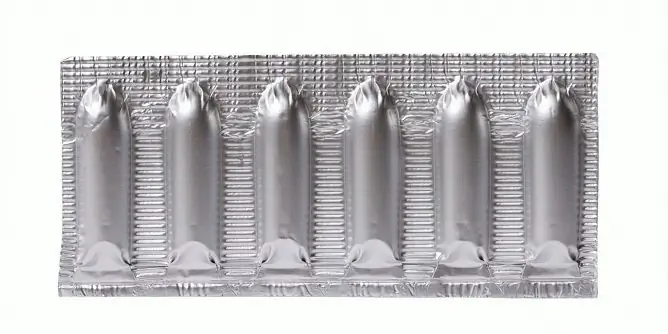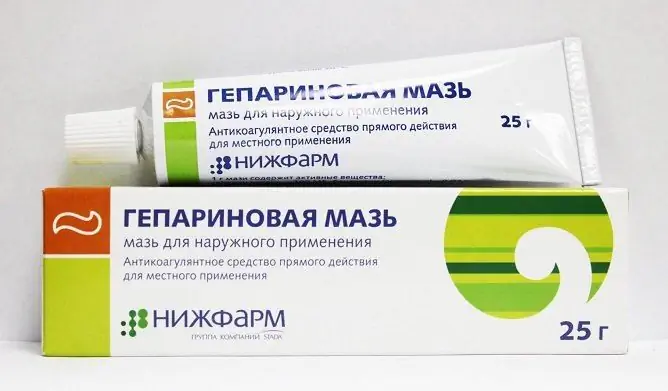- Author Rachel Wainwright [email protected].
- Public 2023-12-15 07:39.
- Last modified 2025-11-02 20:14.
Estriol
Instructions for use:
- 1. Composition and form of release
- 2. Pharmacological properties
- 3. Indications for use
- 4. Instructions for use
- 5. Contraindications
- 6. Side effects

Estriol (international name - Ovestin) belongs to a group of hormonal drugs that normalize hormonal levels, relieve inflammation of the genital mucosa, and also eliminate the symptoms of menopause. The drug helps to restore the vaginal epithelium and normalizes its microflora.
Composition and form of release
The main active ingredient is Estriol 0.5 mg.
Auxiliary components: dimethyl sulfoxide, suppository.
Estriol is available in the form of 0.5 mg vaginal suppositories, vaginal ointment in 15 g tubes and 2 mg tablets, placed in a carton of 30 pcs.
Pharmacological properties of Estriol
Estriol normalizes the condition of the vagina, eliminates the consequences of atrophic changes during menopause in women and increases the protective functions of the vaginal epithelium against infectious processes and inflammation. The drug has a regenerating, anti-inflammatory and antimicrobial effect.
The main components of Estriol normalize blood cholesterol levels, improve microcirculation and increase plasma volume.
Estriol is completely absorbed and reaches its maximum plasma concentration within 2 hours. The drug is excreted by the kidneys in the urine. The therapeutic effect lasts 15-18 hours.
You should not take Estriol during pregnancy, as there may be serious risks to the preservation and proper development of the fetus.
Indications for use
Estriol is indicated for use in atrophic processes of the mucous membranes of the genitourinary system, severe symptoms of menopause in women (itching, burning, inflammation, hot flashes, fever, etc.), during the rehabilitation period after operations on the genitals, infertility, urinary disorders, dyspareunia, urinary incontinence.
Instructions for the use of Estriol
According to the instructions, Estriol suppositories must be injected into the vagina with atrophic processes and inflammation. The course of treatment lasts 3-4 weeks. The exact therapeutic and maintenance dosage of the drug is determined by the attending physician according to the patient's indications. Suppositories Estriol is introduced gradually at 0.5 g 2 times a day.
Estriol tablets are taken at 4-8 mg 1 time per day for 1 month. A second course of treatment is prescribed by a doctor after an interval of 3-4 weeks. The dosage of the drug is gradually reduced to 0.25 mg per day.
Ointment Estriol must be injected into the vagina 2-3 times a day, 0.5 mg for 3 weeks, and then 0.25 mg once a day for 2 weeks.
During the period of treatment with Estriol, you should regularly undergo a medical examination with a full list of diagnostic procedures (blood test, ECG, immunodiagnostics, etc.).
Contraindications

Contraindications to the appointment of Estriol are hypersensitivity and intolerance to the components of the drug, thrombosis, thrombocytopenia, renal and hepatic failure, internal bleeding, malignant tumors, hypertension, epilepsy, heart failure.
Estriol is strictly contraindicated during pregnancy and during breastfeeding, as well as under the age of 18.
With caution, the drug is prescribed for migraine, severe diseases of the gastrointestinal tract, mastopathy, porphyria and circulatory disorders.
Side effects of Estriol
Estriol can cause vomiting, nausea, dizziness and headache, pigmentation, breast inflammation and tenderness, muscle cramps, hypertension, visual impairment.
With a long course of treatment, allergic reactions may appear - itching, burning, dry skin, urticaria, Quincke's edema, bronchospasm, skin rash.
Information about the drug is generalized, provided for informational purposes only and does not replace the official instructions. Self-medication is hazardous to health!






